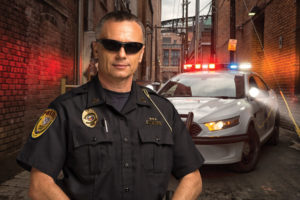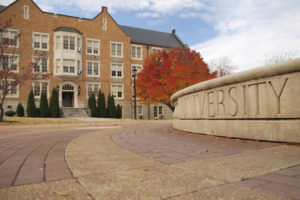 As another school year approaches, university police departments are gearing up for the large numbers of students, faculty, staff, and community that will converge on university grounds. With the fluctuating amount of people on campuses on any given day, university administrators understand reliable communications is essential to the safety and welfare of a university’s permanent and transitory population.
As another school year approaches, university police departments are gearing up for the large numbers of students, faculty, staff, and community that will converge on university grounds. With the fluctuating amount of people on campuses on any given day, university administrators understand reliable communications is essential to the safety and welfare of a university’s permanent and transitory population.
Security Staff and Crowd Control
Security staff is responsible for maintaining order, deescalating potential threats and conflicts, and coordinating first aid efforts during a crisis. They patrol heavily trafficked areas in and around campuses. Officers and security personnel may be put on duty at research centers and similar facilities that house sensitive, historic or classified materials. When department communication is directly tied in with local law enforcement, security administrators can report emergency incidents directly to first responders.
Crowd control crews work with campus security and are usually present at events that expect high attendance. These events include athletic competitions, music concerts, special events (PDF), and graduation ceremonies. Although crowd control staff is stationed throughout a venue, two-way radios allow teams to communicate information or instructions quickly. For example, A crowd control officer who witnesses a disorderly or intoxicated patron enter a venue can use radio communications to instruct staff inside the facility to monitor the individual whose behavior may cause an altercation or incident.
Two-Way Radio Systems
Two-way radio is a cost-effective and reliable alternative to commercial wireless and landline network. Radio networks are usually constructed with redundant infrastructure and backup power, ensuring communication continues despite a natural disaster or prolonged power outage. A privately controlled digital radio system can bypass cellular and landline networks, which often become unstable and overcrowded during critical situations. Moreover, two-way radios do not accrue monthly service or usage fees commonly associated with cell phones.
 There are many ways to configure a digital two-way radio network. One popular configuration among universities is a digital receiver voting system, which combines voting technology with internet protocol (IP) connectivity. Digital receiver voting uses existing hardware (reconfigured as dedicated receivers) and flexible IP to constantly monitor sites and find the best signal for transmission. This approach would benefit university police departments looking for exceptional talkback capability in-building, radio communication from basement level to top floor, and wide area mobile coverage across campus.
There are many ways to configure a digital two-way radio network. One popular configuration among universities is a digital receiver voting system, which combines voting technology with internet protocol (IP) connectivity. Digital receiver voting uses existing hardware (reconfigured as dedicated receivers) and flexible IP to constantly monitor sites and find the best signal for transmission. This approach would benefit university police departments looking for exceptional talkback capability in-building, radio communication from basement level to top floor, and wide area mobile coverage across campus.
Radio Functionality
Two-way radios offer instant communication at the touch of a button for every subscriber unit in the field. Routine shift reporting can be done efficiently over the air and safety personnel can respond quickly should an emergency or crowd disturbance arise. With the use of Radio Access Number (RAN) codes, university radio systems can be segmented into different talk groups. Communication can be organized according to department, location or any other configuration. Pertinent information can be exchanged between individuals (“one-to-one”) and groups (“one-to-many”).
In addition to organizing talk groups, campus police can keep their radio conversations private from individuals trying to monitor communications. Certain digital radios available on the market offer digital encryption or a built-in voice scrambler to keep communication private. To eliminate additional security threats, some devices feature a radio “stun/kill/revive” function, which disables the radio over the air. Reviving a lost or stolen radio requires a legitimate user to enter a password, or having a revive command sent directly to the radio.
Interoperable, “mixed mode” operation is another communications priority for campus police departments. Mixed mode communication allows analog and digital signal reception on a single channel, but radio response uses only one signal type. This valuable capability is useful for universities that are converting to a digital system but are still employing analog radios during the transition.
Physical Features
Campus police and security departments should invest in radios that are simple to use and durable. Mobile and portable units should have large buttons and knobs that are easy to operate even while wearing gloves and other protective gear. For enhanced usability, some radios on the market have a “channel announcement” feature that audibly reports a channel number when the channel knob is rotated. This is especially convenient for drivers who operate mobile units in their university patrol vehicles or campus shuttle vans.
When trying to control crowds and coordinate security in a noisy environment, having a radio that can transmit and receive intelligible audio is crucial. Some manufacturers have a built-in bridge-tied load (BTL) amplifier that can deliver between 700mW to 800mW of loud audio output. For radios operating in digital, users will appreciate the distinct audio clarity that’s exchanged, regardless of communications range.
Land mobile portable radios are used both indoors and outdoors, so an ideal subscriber unit should be capable to withstand heavy use, inclement weather and any accidental damage (e.g. dropping a radio on pavement). To ensure the durability of a handheld radio, university purchasers should look to manufacturers whose products have undergone rigorous industry testing and offer factory-certification.
Managers can also search for radios with an Ingress Protection (IP) rating. Many consumer electronics, including two-way radios, use this scale to define the level protection a device has against foreign matter and moisture. For Instance, a radio with an IP67 code has the highest rating for dust-tight construction and can be submersed in approximately 3 feet of water for up to
30 minutes.
For maximum physical protection, security teams should also consider employing radios that meet MIL-STD 810 requirements. MIL-STD 810 is a U.S. Military Standard that measures products’ durability against strict environmental factors. Two-way radios that meet military specifications are tested under external factors such as temperature, humidity, vibration and shock.

